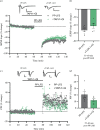Alpha-secretase inhibition impairs Group I metabotropic glutamate receptor-mediated protein synthesis, long-term potentiation and long-term depression
- PMID: 38853546
- PMCID: PMC11343310
- DOI: 10.1098/rstb.2023.0481
Alpha-secretase inhibition impairs Group I metabotropic glutamate receptor-mediated protein synthesis, long-term potentiation and long-term depression
Abstract
Group I metabotropic glutamate receptors (Gp1-mGluRs) exert a host of effects on cellular functions, including enhancement of protein synthesis and the associated facilitation of long-term potentiation (LTP) and induction of long-term depression (LTD). However, the complete cascades of events mediating these events are not fully understood. Gp1-mGluRs trigger α-secretase cleavage of amyloid precursor protein, producing soluble amyloid precursor protein-α (sAPPα), a known regulator of LTP. However, the α-cleavage of APP has not previously been linked to Gp1-mGluR's actions. Using rat hippocampal slices, we found that the α-secretase inhibitor tumour necrosis factor-alpha protease inhibitor-1, which inhibits both disintegrin and metalloprotease 10 (ADAM10) and 17 (ADAM17) activity, blocked or reduced the ability of the Gp1-mGluR agonist (R,S)-3,5-dihydroxyphenylglycine (DHPG) to stimulate protein synthesis, metaplastically prime future LTP and elicit sub-maximal LTD. In contrast, the specific ADAM10 antagonist GI254023X did not affect the regulation of plasticity, suggesting that ADAM17 but not ADAM10 is involved in mediating these effects of DHPG. However, neither drug affected LTD that was strongly induced by either high-concentration DHPG or paired-pulse synaptic stimulation. Our data suggest that moderate Gp1-mGluR activation triggers α-secretase sheddase activity targeting APP or other membrane-bound proteins as part of a more complex signalling cascade than previously envisioned. This article is part of a discussion meeting issue 'Long-term potentiation: 50 years on'.
Keywords: alpha-secretase; hippocampus; metabotropic glutamate receptors; protein synthesis; synaptic plasticity.
Conflict of interest statement
We declare we have no competing interests.
Figures





Similar articles
-
Downregulation of the metalloproteinases ADAM10 or ADAM17 promotes osteoclast differentiation.Cell Commun Signal. 2024 Jun 11;22(1):322. doi: 10.1186/s12964-024-01690-y. Cell Commun Signal. 2024. PMID: 38863060 Free PMC article.
-
GALM Alleviates Aβ Pathology and Cognitive Deficit Through Increasing ADAM10 Maturation in a Mouse Model of Alzheimer's Disease.Neurosci Bull. 2025 Aug;41(8):1377-1389. doi: 10.1007/s12264-025-01386-4. Epub 2025 Mar 24. Neurosci Bull. 2025. PMID: 40128515
-
Enhancement of long-term depression by soluble amyloid β protein in rat hippocampus is mediated by metabotropic glutamate receptor and involves activation of p38MAPK, STEP and caspase-3.Neuroscience. 2013 Dec 3;253:435-43. doi: 10.1016/j.neuroscience.2013.08.054. Epub 2013 Sep 5. Neuroscience. 2013. PMID: 24012839
-
The Black Book of Psychotropic Dosing and Monitoring.Psychopharmacol Bull. 2024 Jul 8;54(3):8-59. Psychopharmacol Bull. 2024. PMID: 38993656 Free PMC article. Review.
-
Systemic pharmacological treatments for chronic plaque psoriasis: a network meta-analysis.Cochrane Database Syst Rev. 2021 Apr 19;4(4):CD011535. doi: 10.1002/14651858.CD011535.pub4. Cochrane Database Syst Rev. 2021. Update in: Cochrane Database Syst Rev. 2022 May 23;5:CD011535. doi: 10.1002/14651858.CD011535.pub5. PMID: 33871055 Free PMC article. Updated.
Cited by
-
Long-term potentiation: 50 years on: past, present and future.Philos Trans R Soc Lond B Biol Sci. 2024 Jul 29;379(1906):20230218. doi: 10.1098/rstb.2023.0218. Epub 2024 Jun 10. Philos Trans R Soc Lond B Biol Sci. 2024. PMID: 38853569 Free PMC article.
References
MeSH terms
Substances
Grants and funding
LinkOut - more resources
Full Text Sources
Miscellaneous

